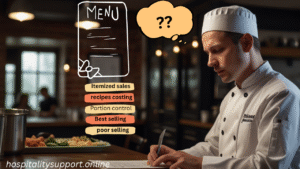
Menu engineering is a strategic approach used in the restaurant management to design and optimize menu to maximize profitability and customer satisfaction. It involves analyzing the popularity and profitability of menu items and using that data to make informed decisions about menu design, pricing, and layout.
Core components of Menu Engineering are :
Cost Analysis
Calculate the food cost of each menu item to check if it is priced correctly and generating the higher gross margin.
Sales Analysis
Check the daily, weekly and monthly sales report to find how often the item is sold. Take 10 best selling and low selling item to check the polularity of menu items.
Classification
Check the itemized sales report and categorized the items in four categories.
- High Popularity
- Low Popularity
- High Profit
- Low Profit
Take appropriate action for each item as per the performance report.
Low profit and low popularity items need immediate attention to get better results.
Menu Layout & Design
Use eye-scanning patterns (e.g., “Golden Triangle”)
Highlight profitable dishes (boxes, icons, chef’s specials)
Limit choices (less cognitive overload)
Psychological Pricing
Avoid whole numbers (e.g., $14.95 vs $15)
Use price anchoring and decoy pricing
Descriptive Labeling
Use sensory or evocative language (e.g., “Grandma’s Apple Pie” vs. “Apple Pie”)
Portion & Ingredient Adjustments
Modify portion sizes or ingredients to enhance profitability
Increases overall profit margin
Helps with inventory control
Improves guest satisfaction by highlighting better-performing items
Informs staff training (which items to upsell)

